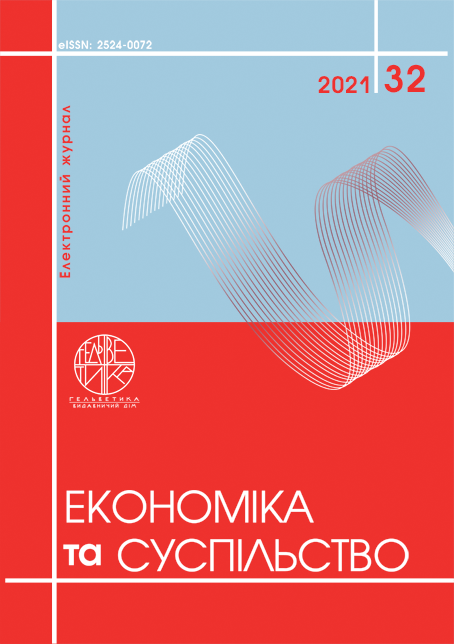METHODICAL PRINCIPLES OF ACCOUNTING SETTLEMENTS WITH EMPLOYEES IN IS «BAS ACCOUNTING CORP»
Abstract
The article is devoted to the important issues of accounting for settlements with employees in the modern information system «BAS Accounting CORP», which allows to improve the accounting process and meet the needs of enterprises and government agencies. The essence and components of payments to employees are defined according to NPSBO 26 «Payments to employees». Payments to employees (NPSBO 26 «Payments to employees») include current payments, dismissal payments, post-employment payments, payments of equity instruments of the enterprise, other long-term payments. A significant part of these payments is occupied by current payments to employees, which include: wages and salaries, other payroll accruals; payments for unworked time (annual leave and other paid unworked time); bonuses and other incentive payments payable within twelve months after the end of the period in which the employees perform the relevant work, etc. In accounting, current payments are reflected in account 66 «Settlements for payments to employees»: sub-accounts 661 «Payroll», 662 «Settlements with depositors», 663 «Settlements for other payments». Liabilities are accrued on credit and disbursements are debited. The main tasks of labor organization and accounting for its payment in the program «BAS Accounting CORP». It was found that the subsystem «Personnel accounting and payroll» in the program «BAS Accounting. CORP» includes two sections «Personnel» and «Salary». The «Personnel» section stores personal data of individuals, the «Salary» section displays information on salary accrual; maintenance; accounting for loans to employees; salary deposit; calculation of personal income tax, military duty and single contribution; calculation of insurance premiums and more. The parameters of working time and wage accounting settings are generalized and a step-by-step organizational model of payroll calculations in IS «BAS Accounting. CORP». It is determined that the main unresolved problem is the development of methodological provisions for the accounting of various objects in the IS «BAS Accounting. CORP».
References
Податковий кодекс України від 02.12.2010 р. № 2755-VI. URL: https://kodeksy.com.ua/podatkovij_kodeks_ukraini.htm (дата звернення: 26.07.2021).
Положення (стандарт) бухгалтерського обліку 26 «Виплати працівникам» від 28.10.2003 № 601. URL: https://zakon.rada.gov.ua/laws/show/z1025-03/conv#Text (дата звернення: 25.07.2021).
Аверкина М.Ф., Гриценюк О.І. Особливості автоматизації обліку праці та заробітної плати. Причорноморські економічні студії. 2018. № 29(2). С. 113–-117. URL: http://nbuv.gov.ua/UJRN/bses_2018_29(2)__25 (дата звернення: 14.11.2021 р.).
Антоненко Н.В., Хоменко В.С. (2016). Використання програмних продуктів в системі автоматизації бухгалтерського обліку. Вісник Національного транспортного університет. 2016. № 3. С. 3–8. URL: http://nbuv.gov.ua/UJRN/Vntu_2016_3_3. (дата звернення: 11.11.2021).
Бойчук А.А., Мельник А.М. Автоматизація обліку на підприємствах України. Наука й економіка, 2016. № 2. С. 22–25. URL: http://nbuv.gov.ua/UJRN/Nie_2016_2_6. (дата звернення: 15.11.2021).
Марусей Т.В., Мушеник І.М. Автоматизація обліку заробітної плати засобами інформаційних технологій. Збірник наукових праць Подільського державного аграрно-технічного університету. Економічні науки. 2015. № 23. С. 127–133. URL: http://nbuv.gov.ua/UJRN/ZnpPdatue_2015_23_15. (дата звернення: 14.11.2021).
Синяєва Л.В., Кондратюк О.В., Микульський В.С. Автоматизація обліку заробітної плати за допомогою програми «1С. Підприємство» конфігурації 2.0. Економіка і організація управління. 2017. № 4. С. 15–26. URL: http://nbuv.gov.ua/UJRN/eiou_2017_4_4. (дата звернення: 13.11.2021).
Юр’єва І.А., Березіна Т.В. Аналіз шляхів удосконалення автоматизації обліку заробітної плати на підприємстві. Вісник Національного технічного університету «ХПІ». Сер. : Технічний прогрес та ефективність виробництва. 2013. № 67. С. 25–29. URL: http://nbuv.gov.ua/UJRN/vcpitp_2013_67_6. (дата звернення: 11.11.2021).
Podatkovyi kodeks Ukrainy [Tax Code of Ukraine]. Retrieved from: https://kodeksy.com.ua/podatkovij_kodeks_ukraini.htm
Polozhennia (standart) bukhhalterskoho obliku 26 «Vyplaty pratsivnykam» [Regulation (standard) of accounting 26 «Payments to employees»]. Retrieved from: https://zakon.rada.gov.ua/laws/show/z1025-03/conv#Text
Averkyna M.F., Hrytsenyuk O.I. (2018). Osoblyvosti avtomatyzatsiyi obliku pratsi ta zarobitnoyi platy [Features of automation of labor and wage accounting]. Retrieved from: http://nbuv.gov.ua/UJRN/bses_2018_29(2)__25 (accessed 14.11.2021).
Antonenko N.V., Khomenko V.S. (2016). Vykorystannya prohramnykh produktiv v systemi avtomatyzatsiyi bukhhaltersʹkoho obliku [The use of software products in the accounting automation system]. Retrieved from: http://nbuv.gov.ua/UJRN/Vntu_2016_3_3 (accessed 11.11.2021).
Boychuk A.A., Melʹnyk A.M. (2016). Avtomatyzatsiya obliku na pidpryyemstvakh Ukrayiny [Automation of accounting at the enterprises of Ukraine]. Retrieved from: http://nbuv.gov.ua/UJRN/Nie_2016_2_6 (accessed 15.11.2021).
Marusey T.V., Mushenyk I.M. (2015). Avtomatyzatsiya obliku zarobitnoyi platy zasobamy informatsiynykh tekhnolohiy [Automation of wage accounting by means of information technology]. Retrieved from: http://nbuv.gov.ua/UJRN/ZnpPdatue_2015_23_15 (accessed 14.11.2021).
Synyayeva L.V., Kondratyuk O.V. Mykulʹsʹkyy V.S. (2017). Avtomatyzatsiya obliku zarobitnoyi platy za dopomohoyu prohramy «1S. Pidpryyemstvo» konfihuratsiyi 2.0. [Automation of payroll accounting using the program «1C. Enterprise» configuration 2.0.] Retrieved from: http://nbuv.gov.ua/UJRN/eiou_2017_4_4
Yuryeva I.A., Berezina T.V. (2013). Analiz shlyakhiv udoskonalennya avtomatyzatsiyi obliku zarobitnoyi platy na pidpryyemstvi [Analysis of ways to improve the automation of payroll accounting at the enterprise]. Retrieved from: http://nbuv.gov.ua/UJRN/vcpitp_2013_67_6


